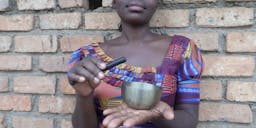LE LANGUE MATERNELLE.
Feb 25, 2020
Story


Langue maternelle est la première langue apprise à la maison dans l'enfance et encore comprise par la personne au moment où les données sont recueillies pour moi ma langue maternelle c’est le swahili suivie de français. Si la personne ne comprend plus la première langue apprise, la langue maternelle est la deuxième langue apprise. Dans le cas d'une personne qui a appris deux langues en même temps dans la petite enfance, la langue maternelle est la langue que cette personne a parlé le plus souvent à la maison avant de commencer l'école. Une personne a deux langues maternelles seulement si les deux langues ont été utilisées aussi souvent et sont toujours comprises par la personne. Dans le cas d'un enfant qui n'a pas encore appris à parler, la langue maternelle est la langue parlée le plus souvent à cet enfant à la maison. Un enfant a deux langues maternelles seulement si les deux langues lui sont parlées aussi souvent, afin qu'il apprenne les deux en même temps.
Les langues constituent les instruments les plus puissants pour préserver et développer notre patrimoine matériel et immatériel. Tout ce qui est fait pour promouvoir la diffusion des langues maternelles sert non seulement à encourager la diversité linguistique et l'éducation multilingue mais aussi à sensibiliser davantage aux traditions linguistiques et culturelles du monde entier et à inspirer une solidarité fondée sur la compréhension, la tolérance et le dialogue.
Une finalité de l’introduction d’une langue vivante en maternelle est de créer les conditions favorables pour donner envie d’apprendre plus tard cette langue.
Les objectifs sont modestes et il ne peut s’agir que d’une sensibilisation à cette langue. Mais la sensibilisation n’est pas exclusive d’apprentissages. Des compétences peuvent en effet être avantageusement travaillées en maternelle. D’une part, les schémas articulatoires des jeunes enfants sont très mobiles et ne sont pas encore « limités » par les automatismes de la langue maternelle. D’autre part, les capacités auditives sont à cet âge peu altérées par une filtration, elle aussi induite par l’exposition aux seuls phonèmes utilisés en français (seulement une trentaine, alors qu’il y en a beaucoup plus en anglais, en allemand ou en espagnol).
L’introduction d’une langue vivante en maternelle peut donc être très bénéfique, tant pour la discrimination auditive, que pour la reproduction de sons, d’intonations et d’accentuations. Cela est d’autant plus important, que ces compétences sont de plus en plus difficiles à acquérir au fur et à mesure que l’enfant grandit. La marionnette est l’élément qui balise dans le temps le moment de langue vivante. Cette identification est nécessaire afin d’éviter toute interférence avec les moments de langue première (surtout pour les enfants dont la langue maternelle n’est pas le français). Durant ces moments, l’enseignant utilise la marionnette pour introduire des éléments de langue vivante qui seront manipulés par la suite. Elle devient ainsi son interlocuteur et celui des enfants. Sa présence, qui dépend de la langue utilisée par les enfants, incite ceux-ci à rester concentrés et à ne pas utiliser la langue première. Grâce à la marionnette, l’unité de temps du moment de langue vivante est donc définie à la fois par son début et sa fin, mais aussi par son contenu bien différencié des autres moments de classe se déroulant en français,le swahili et le français sont deux langues qui domine la r d congo,
merci, ces gens parlent leur langue maternelle en marchant vers les camps de refuges
English translation by community member liannareed
Mother Tongue
The mother tongue is the first language learned in the house in infancy and still understood as of today. My mother tongue is Swahili followed by French. If the person no longer understands the first language learned, the second language becomes the mother tongue. In the case of a person who learns two mother tongues at the same time as a child, it is the language that this person speaks often at home before going to school. A person with two mother tongues has two languages if both are used often and if they are always understood by the person. In this case, the child has not yet learned how to speak, the mother tongue is the spoken language the most often for the children.
The languages make up the most powerful instruments for preserving and developing our heritage both material and immaterial. All that is done for the promotion of the diffusion of mother tongues, not only to encourage linguistic diversity and multilingual education but also to raise awareness of the advantages to linguistic and cultural traditions in the world and to inspire solidarity founded on understanding, tolerance and dialogue. An introductory purpose to the another language in kindergarten is to create the favorable conditions for children to want to continue to learn later in life.
The objectives are modest and it can only be an awareness of the languages. But the awareness is not limited to learning. The competences can in effect be advantageous in kindergarten. On the one hand, the articulated patterns of young children are very mobile and are not yet limited by the automatization of the mother tongue. On the other, the auditory capacities are at this age, not altered by filtration and by phonemes used in French (only 30 while there are many more in English, German, or Spanish).
The introduction of a living language in kindergarten is very beneficial for auditory discrimination, for the reproduction of sounds, intonations and accentuations. It is very important that these competencies, which are more and more difficult to acquire are available for children as they grow up. The puppet, used in class, is the element that marks the time of the living language. This identification is necessary in the end to avoid all interference of moments of the first language (especially for children whose mother tongue is not French). During these times, the teacher uses puppetry to introduce the elements of a spoken language, which will be introduced later. The presence which depends on the language spoken by the children, encourages them to stay focused and not use their first language. Thanks to puppetry, the amount of time speaking the first language is designated by both the beginning and the end but also by the differentiated content and the other moments of class that are spoken in French. Swahili and French are the two main languages in the DRC.
Thank you, these people speak their mother tongue and walk on towards the refugee camps.




